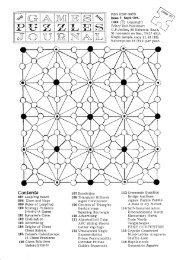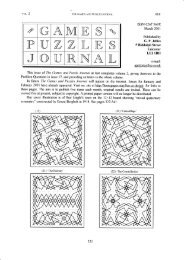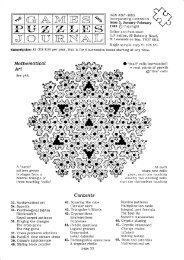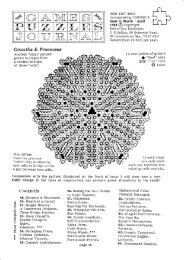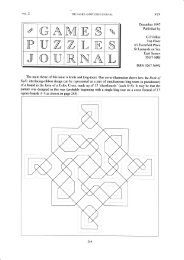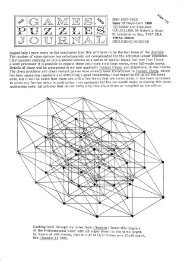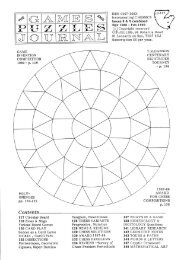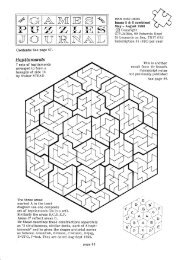Chessics, #28 - Mayhematics
Chessics, #28 - Mayhematics
Chessics, #28 - Mayhematics
You also want an ePaper? Increase the reach of your titles
YUMPU automatically turns print PDFs into web optimized ePapers that Google loves.
cnesstcs zs<br />
Chequered and One-Sided Pieces<br />
Solution to problem 152 in <strong>Chessics</strong> 23: To dissect a chessboard into the<br />
maximum number of pieces, all dFrent in size, shape or colouringr given that<br />
the board is marked with squares on both sides and is (a) unchequered on both<br />
sides (b) chequered on one side (c) chequered on both sides, the reverse of black<br />
being black (b) cnequered on both sides, the reverse of black being white. Four<br />
solutions for these eases are illustrated below. A fifth case can be added: (e)<br />
the board is all black on the back (in other words the pieces are one-sided and<br />
may not be turned over), butanV solution of (a) also solves this case.<br />
(e) 16 Pieces (b) L 8 pieces (c) 1B pieces (d) 16 pieces<br />
G.P.J.<br />
S.L.<br />
G.P.J.<br />
The numbers of different n-ominoes in the 5 cases are as follows:<br />
nt2345678<br />
(a) 1 1 2 5 72 35108369<br />
(b) 2 | 4 10 36 110 392 137L<br />
(c) 2 1 4 7 24 642L6 718<br />
(d) 1 1 2 6 18 55196685<br />
(e) 1 1 2 7 18 60 196 704<br />
G.P.$"<br />
The method of arriving at the so-Iutions can be illustrated by case (b). To get the<br />
maximum number of pieces we must try to use as many as possible of the smaller<br />
sizes. We have 2 of. size 1, 1 of size 21 4 of. size 3, 10 of size 4, and we find 64 =<br />
ZxI + 1x2 + 4x3 + 10x4 + 1x5 + 3. The remainder of 3 squares can be used up by<br />
selecting an 8-square piece instead of the 5, or a ?-square piece instead of a 4,<br />
or similarly. The number of pieces used is 2+1+4+10+L = 18r the maximum. The<br />
problem for this case was first set and solved by Sam Loyd in his Puzzle Magazine<br />
(April-July 1903). The numbers in row (b) of the table are taken from an analysis<br />
of Loyd's problem by F.Hansson in FCR Nov 1939.<br />
The other rows of the above table are the results of my own calculations<br />
(and so could do with an independent check). An indication is in order of how they<br />
rvere arrived at. The calculations can be put in the form: e= 2a - P; c = 2a -(q+r),<br />
b= 2e - (q+2r), d = e -s, where: p = number of pieces of type (a) tnat are axially<br />
symmetric, q = number that are axi-symmetric and in which reversal of colours<br />
is equivalent to rotation, r = number that are not axisymmetric but possess the<br />
colour-change rotation propertVr s = number of singly-centrosymmetric pieces<br />
of an even number of squares. Readers may tike to try to identify the particular<br />
pieces that possess these special properties (1 of size 2,3 of. size 41 7 of size 6'<br />
22 of. size 8). Furthbr details will be given in a later issue.<br />
Answer to problem 153: No cuts are needed to convert a2x4 rectangle to a<br />
3x3 square - the rectangle is made out of wire (12 units length) and bent to shape!<br />
page 1 50




